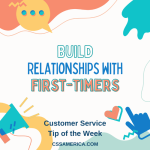No, this is not a take off on the Bobby McFerrin song: Don’t Worry Be Happy.
It’s actually a take off on the John Wooden quote: Be quick, but don’t hurry.
When I read Wooden’s book with this title, I liked the concept, and not just because John Wooden was a great basketball coach and – apparently – a great person. With his UCLA Bruins college basketball teams, he had success that has never been rivaled – having won 10 NCAA tournament championships. And that is not a typo – 10!
Wooden said that if you’re in a hurry, you make mistakes. He doesn’t want mistakes. He wants achievement.
In order to be quick, it helps tremendously to know what to do. You can achieve more if you’re quick, efficient, with little wasted motion or effort.
I guess that a less creative way to say “Be quick, but don’t hurry” is to say: You can achieve more the more you know, and the fewer mistakes you make.
Never lose sight of the fact that hurrying through things can hurt the quality of your customer service. Rushing conversations, speeding through forms and documents without reviewing, avoiding a QA check because “I’ve done this 1000 times,” or skipping a few process steps – these all can result in mistakes, in issues, in rework, in complaints.
And never forget that the more you invest in your knowledge of people, processes, systems, policies, and places, the better equipped you are to handle things right the first time, and usually with less help.
Look at your job through the eyes of a master teacher – Be quick, but don’t hurry.
Signup for FREE Tips! Contact Us More Resources for You Visit Our Home Page
























